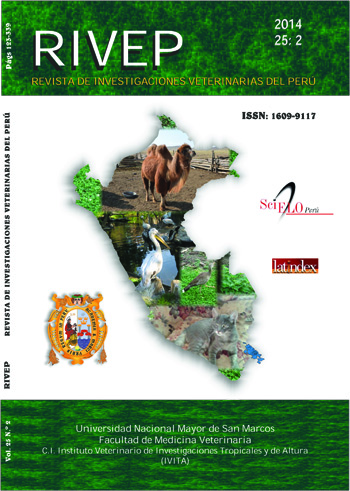EFFECT OF SUPPLEMENTATION WITH COPPER SOURCES ON BROILER PERFORMANCE,INTESTINAL MORPHOLOGY AND LIVER COPPER CONTENT
DOI:
https://doi.org/10.15381/rivep.v25i1.8464Keywords:
copper, broilers, liver, intestinal villusAbstract
This study aimed to evaluate the effect of different copper sources on broilerperformance, intestinal morphology and liver copper contents. Two hundred one-dayold Cobb 500 male chicks were randomly distributed into five groups, using 4 replicates and 10 birds per replicate. The treatments were: T1, basal diet containing antibiotic(positive control); T2, basal diet without antibiotic (negative control); T3, as T2 + 250ppm Cu from copper sulphate; T4, as T2 + 250 ppm Cu from copper oxychloride; T5, T2 +250 ppm Cu from tribasic copper chloride. No significant differences were found betweentreatments on final body weight, daily body weight gain, cost/benefit ratio and carcassyield. The lowest feed intake and the best feed efficiency were observed in T2 as comparedto T1 and T2 (p<0.05). The highest copper content in liver occurred in T5 (p<0.05).Copper supplements affected villus height and area in jejunum as compared to the control groups. It is concluded that supplementation with 250 ppm Cu from copper sulphateimproves feed efficiency and that copper supplementation regardless the source affectedintestinal morphology.Downloads
Downloads
Published
Issue
Section
License
Copyright (c) 2014 Otto Zea M., Carlos Vílchez P.

This work is licensed under a Creative Commons Attribution-NonCommercial-ShareAlike 4.0 International License.
AUTHORS RETAIN THEIR RIGHTS:
a. Authors retain their trade mark rights and patent, and also on any process or procedure described in the article.
b. Authors retain their right to share, copy, distribute, perform and publicly communicate their article (eg, to place their article in an institutional repository or publish it in a book), with an acknowledgment of its initial publication in the Revista de Investigaciones Veterinarias del Perú (RIVEP).
c. Authors retain theirs right to make a subsequent publication of their work, to use the article or any part thereof (eg a compilation of his papers, lecture notes, thesis, or a book), always indicating the source of publication (the originator of the work, journal, volume, number and date).










